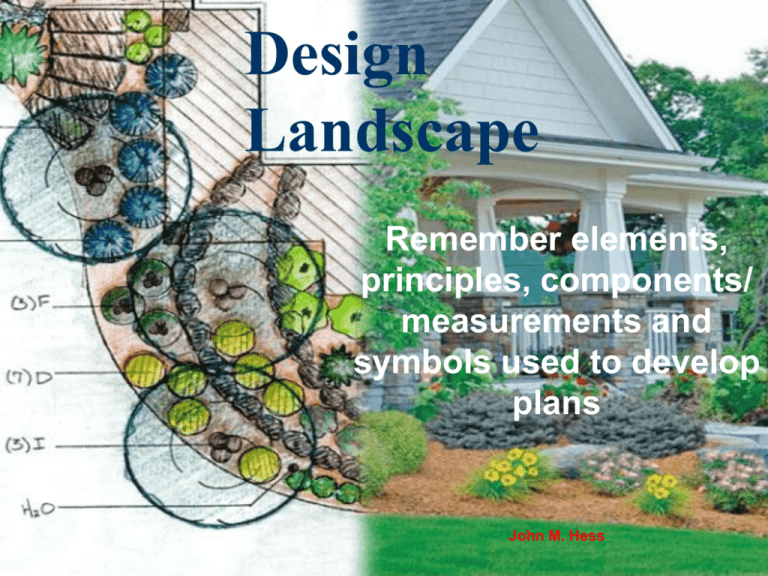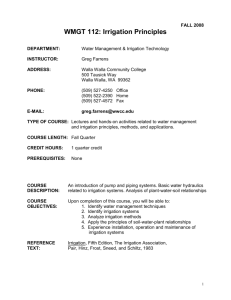PPT 4.01-Elements of Landscape Design.ppt
advertisement

Design Landscape Remember elements, principles, components/ measurements and symbols used to develop plans John M. Hess Elements of Design Design Elements create moods or feeling of the Observer: Form- Geometric shape or combination of shapes Elements of Design ■ Line – Continuity of a landscape….Flow of the landscape ■ Straight lines = direction change ■ Curved lines= relaxed movement Element of Design ■ Texture: Coarse or fine materials used. ■ ■ ■ ■ ■ Examples. Size differences of leaves stones brick bark Elements of Design: Overview ■ The five elements of landscape design include: ■ • Color - It is important to use a complementing color scheme ■ ■ ■ ■ throughout the yard. • Line - Linear patterns are used to direct physical movement and to draw attention to areas in your garden. • Form - Form can be expressed through trees and shrubs of various shapes and sizes which create natural patterns. • Texture - Plants with varying textures can add to the atmosphere of your outdoor area. • Scale - Your outdoor design should balance the size of the buildings it surrounds, while maintaining a comfortable environment for the individuals who will use the area. Principles of Design ■ Principles of design- Standards by which designs can be created, measured, discussed and evaluated. Principles of Design ■ Balance: Even distribution of materials on opposite sides of a central axis. ■ ■ ■ Symmetric – both sides are identical (mirror image). Asymmetric – visual weight on opposite sides is the same, but materials used and their placement may vary. Proximal/Distal – Same as asymmetric with depth in the field of vision added. Balance: Symmetric: Formal Balance Asymmetric: Informal Balance Proximal / Distal: Principles of Design: ■ Focalization – Selects and positions visually strong items into landscape. Catchs and draws viewer to key feature in landscape. ■ ■ ■ ■ Hardscapes Color movement Unique plant or Specimen plant Principles of Design: ■ Simplicity – Seeks to make the viewer feel comfortable within the landscape. Principles of Design: ■ Proportion – Concerned with size relationship between all the features of the landscape. Principles of Design: ■ Rhythm and Line: When something repeats itself enough times with a standard distance between repetitions, rhythm is established. Principles of Design: ■ Unity – The master principle combining all other principles. Total design Methods of Grouping Plants ■ Corner Planting – Planting is placed at the corner of a landscape. One of the more natural locations for a focal point. ■ ■ ■ Bench Specimen plant Hardscape Methods of Grouping Plants ■ Foundation Planting – Plants lining walls or walkways to soften edges. Can be used to draw attention to entrances or openings. Methods of Grouping Plants: ■ Line Planting – Creates a wall or line in the landscape. Used as screening or privacy. Helps to create outdoor living area. Methods of Grouping Plants: ■ Mass Planting – A group of [plants that fill a large area or cluster in the landscape. Methods of Grouping Plants: ■ Accent Plant – Creates a particular beauty or interest in the landscape. Used to draw viewer’s eye to an area, or to create an illusion that area is larger than it appears. ■ Accent plants should not be placed in middle of lawn area. Accent Plant : Examples Criteria for Lettering/Numbering Plans and for using scales. ■ Use single strokes when forming ■ ■ ■ ■ ■ letters/numbers. Always use all CAPITAL (upper case) letters. Use light strokes when lettering/numbering to avoid smudges. Draw letters/numbers vertically. Use appropriate spacing when lettering/numbering. Use guidelines always. Show uniformity in letters/numbers. Examples of Lettering: 1 Lettering Examples: 2 Using Scales: ■ Architect / engineering scales may be used to represent actual dimensions of land / objects on paper. ■ The scale is NOT used as a straight edge. It is a measuring device only. ■ Architect scales hold several units of measure for sizing to paper. ■ NOTICE** Rulers are kings and queens, not items for drawing or measuring. Symbols for diagrams/ Layouts ■ Evergreen Tree: Symbols for Diagrams / Layouts ■ Deciduous Tree: Shrub Symbols ■ Evergreen: ■ Deciduous: Ground Cover Symbols ■ Ground Cover: Annual Plant Symbols: ■ On a landscape plan, annuals do not have a symbol. One must simply draw an arrow on the plan to the area where annuals are to be planted and put the word “Note”. Then in the listing of plants, the annuals are listed by the word note. Symbols: ■ Paver- Brick: Symbols: ■ Water feature: Depending on the feature the symbol normally takes the relative bird’s eye view of the feature, shape outline. Small water feature are normally symbolized as a circle with a center dot ( circle should be to scale of feature). Symbols: ■ Lighting: Lighting symbols are based on design of lighting, lights can be represented by filled squares, circles, triangles. Symbols in a series should be connected by a line to represent circuit and power source. ■ Triangles represent hanging light fixtures. ■ Circles and squares normally represent fixed lights of the approximate shape of symbol. Symbols: Patios, Decks, Drives ■ Concrete, Wood, Brick and Stone Miscellaneous Symbols ■ North Arrow: ■ Scale: ¼” = 1’ ■ Scale is located in title box ■ Title Box: Holds all vendor /client and drawing information. Legal and binding. Irrigation System Components: ■ Sprinkler Irrigation – Applies water under pressure over the tops of plants. Irrigation System Components ■ Drip /Trickle Irrigation – Supplies water directly to the root system of the plant. Types of Sprinkler Heads: ■ Spray head – Water is distributed in a set pattern over a fixed area. ■ ■ ■ No moving parts normally. Propels water 14 -16 ft, before wind affects pattern. Most commonly use for shrubs and flower beds. Types of Sprinkler Heads: ■ Rotary Sprinklers – Have moving parts, Some are pop – ups. ■ Move in full circle or partial circles. ■ Throw water up to 110 ft. ■ Gear or impact driven. Types of Sprinkler Heads: ■ Pop – up Sprinklers – Sprinkler heads rise above ground when water pressure is applied, Return to ground level when pressure is released. ■ Positive retract use a spring to return nozzle to ground level. ■ May be rotary sprinklers or fix spray heads. Pop – up Sprinklers: Examples Types of Sprinkler Heads: ■ Emitters – A device to take the place of a sprinkler head for trickle irrigation. Types of Sprinkler Heads: ■ Microspray – Low volumeemission device that waters the entire hydrozone and operates similarly to conventional spray heads, but at much lower flow rates. ■ ■ Drip irrigation uses up to 50 % less water than sprinkler systems. Uses 150 -200 micron mesh filter to prevent clogging. Other Irrigation Components: ■ Back Flow Preventer – Device that ensures water from irrigation system does not return back to main water source. ■ This is required in some counties if on city water. Other Irrigation Components: ■ Remote Control Valves – Devices that open and close to allow water flow through pipes. ■ Placed in the water line and controlled by an electrical contact with the irrigation system controller. Other Sprinkler Components: ■ Controller – The device that automatically opens/ closes the valves in the irrigation system according to the preset program. Sold based on the number of valves to be controlled. ■ ■ Controllers are programable. Other Sprinkler Components ■ Program – A set of instructions for the controller to follow : Days for watering, water flow & length. (Some will skip days based of rain). ■ Zone – Area or grouping of sprinklers, operating on a certain control valve. ■ Cycle – One complete run of a controller through its programmed stations/ zones. Other Sprinkler Components: ■ Main Line – Main source of water in an irrigation system, has water flow or pressure at all times. ■ Lateral Line – Secondary line of an irrigation system that has water flow / pressure when valve is open. Irrigation Measurements: ■ GPM – Gallons per minute. Rate of water flow through an irrigation system, time = 1 minute. ■ GPH – Gallons per hour. Rate of water flow through an irrigation system, time = 1 hour. ■ PSI – Pounds per square inch. Measure of force at which water moves through the irrigation system. Irrigation Symbols: ■ Irrigation Symbols are normally a universal system, some symbols may differ based on designer or design program. Check out the site below to see a auto - cad system’s symbols. ■ www.Softwarerepublic.com





